- The paper presents a direct dynamical measurement of a ~5×10^7 M⊙ black hole using the Keplerian rotation of narrow Hα emission in a high-redshift Little Red Dot.
- It employs high-resolution JWST/NIRSpec IFS data and spectroastrometry to robustly distinguish between point mass and extended mass models.
- The results reveal an extreme BH-to-stellar mass ratio in a chemically pristine environment, supporting heavy seed formation scenarios in the early universe.
Direct Dynamical Measurement of a Black Hole in a Little Red Dot at z=7.04
Introduction
This paper presents a direct dynamical measurement of the black hole (BH) mass in Abell2744-QSO1, a strongly lensed, high-redshift active galactic nucleus (AGN) classified as a "Little Red Dot" (LRD) at z=7.04. LRDs are characterized by optically red continua, blue UV slopes, and X-ray weakness, complicating standard AGN template fitting and challenging the reliability of single-epoch virial BH mass estimates. The authors utilize deep JWST/NIRSpec integral field spectroscopy (IFS) and gravitational lensing to resolve the kinematics of the narrow Hα emission, enabling a robust dynamical mass measurement. The analysis demonstrates that the observed rotation curve is inconsistent with any plausible extended stellar or dark matter distribution, and is best explained by Keplerian rotation around a point mass, yielding a BH mass of MBH∼5×107 M⊙. The inferred BH-to-stellar mass ratio MBH/M∗>2 is orders of magnitude above local scaling relations, indicating a "naked" black hole in a chemically pristine environment.
Observational Data and Kinematic Mapping
The paper leverages high-resolution NIRSpec IFS data, resampled to 0.02" pixel scale, focusing on the narrow Hα emission after subtraction of broad line and continuum components. The spatial and kinematic maps reveal a velocity gradient of ∼10 km s−1 across ∼200 pc, with the emission resolved into two beams due to lensing magnification and JWST's spatial resolution.
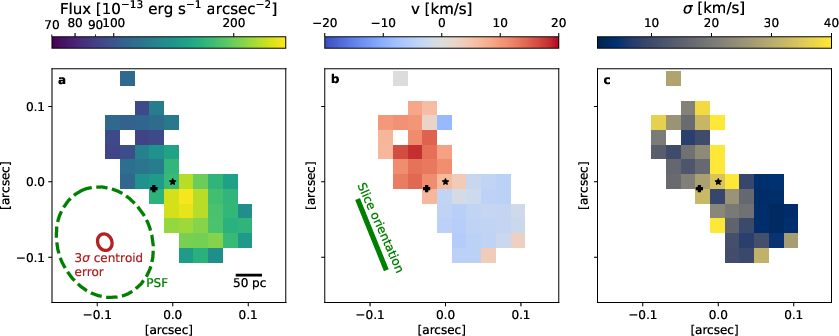
Figure 1: Hα narrow line emission and kinematics maps of QSO1, showing surface flux, velocity field, and velocity dispersion σv.
The velocity field is aligned with the IFU slicer, ruling out calibration artifacts. The narrow line region is spatially extended, while the continuum remains unresolved, supporting the AGN classification.
Rotation Curve Construction and Spectroastrometry
The rotation curve is sampled by binning spaxels at 50, 100, and 150 pc from the dynamical center, with velocities corrected for dispersion support. To probe sub-beam scales, spectroastrometric techniques are employed, measuring centroid separations in velocity channels. The separation of 24.9±9.4 pc between red and blue wings yields a spectroastrometric radius rspec=12.5±4.7 pc and an enclosed mass lower limit log(Mspec/M⊙)=6.90±0.23 (uncorrected for inclination).
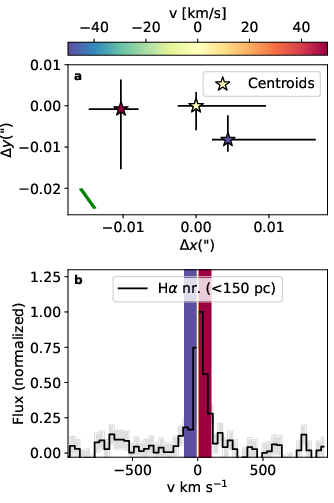
Figure 2: Spectroastrometry on the narrow line, showing centroid locations and the extracted line profile.
Dynamical Modeling: Point Mass vs. Extended Distributions
The authors fit the rotation curve with both a point mass (Keplerian) and extended mass models (Milky Way-like nuclear star cluster, Plummer sphere, NFW dark matter profile). The point mass model yields log(MBH/M⊙)=6.94±0.15 with χR2=0.8, while the NSC model is strongly disfavored (χR2=3.8) and collapses to a point mass when the scale radius is left free. The Plummer sphere and NFW models similarly reduce to unphysically compact configurations, indicating that any extended mass component is subdominant at <200 pc scales.
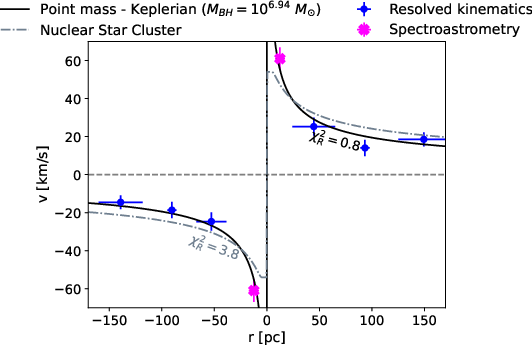
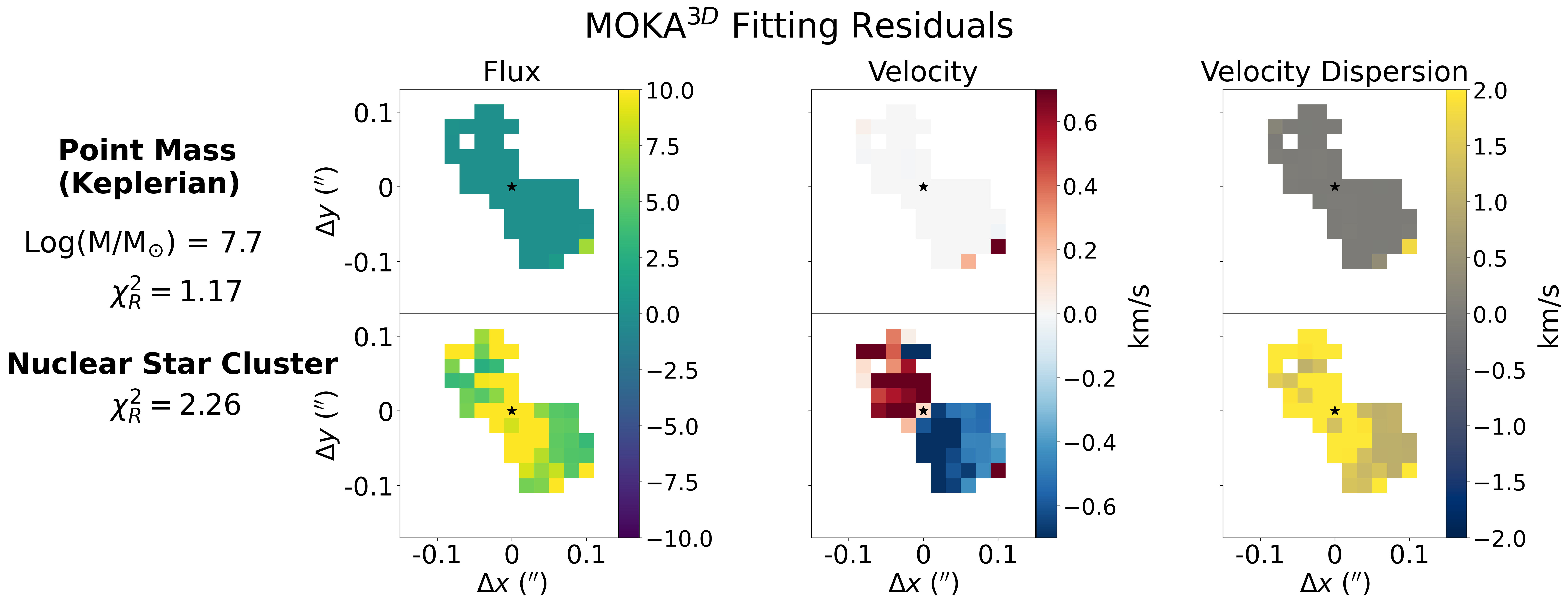
Figure 3: Direct dynamical measurements of the black hole mass, showing the rotation curve and residuals for point mass and NSC models.
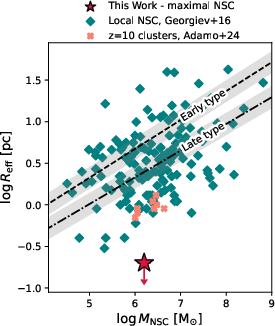
Figure 4: Comparison between QSO1 and star cluster observations on the mass-radius plane, demonstrating the implausibility of a NSC in QSO1.
Robustness: 3D Kinematic Modeling and Systematics
To account for instrumental effects, the MOKA3D framework is used for 3D kinematic modeling, incorporating PSF, inclination, and flux distribution. The best-fit model is Keplerian rotation around a point mass with log(MBH/M⊙)=7.7±0.3 and inclination 52∘±2∘, consistent with spectroastrometric lower limits. Non-parametric disk models yield consistent inclination estimates across independent rings.
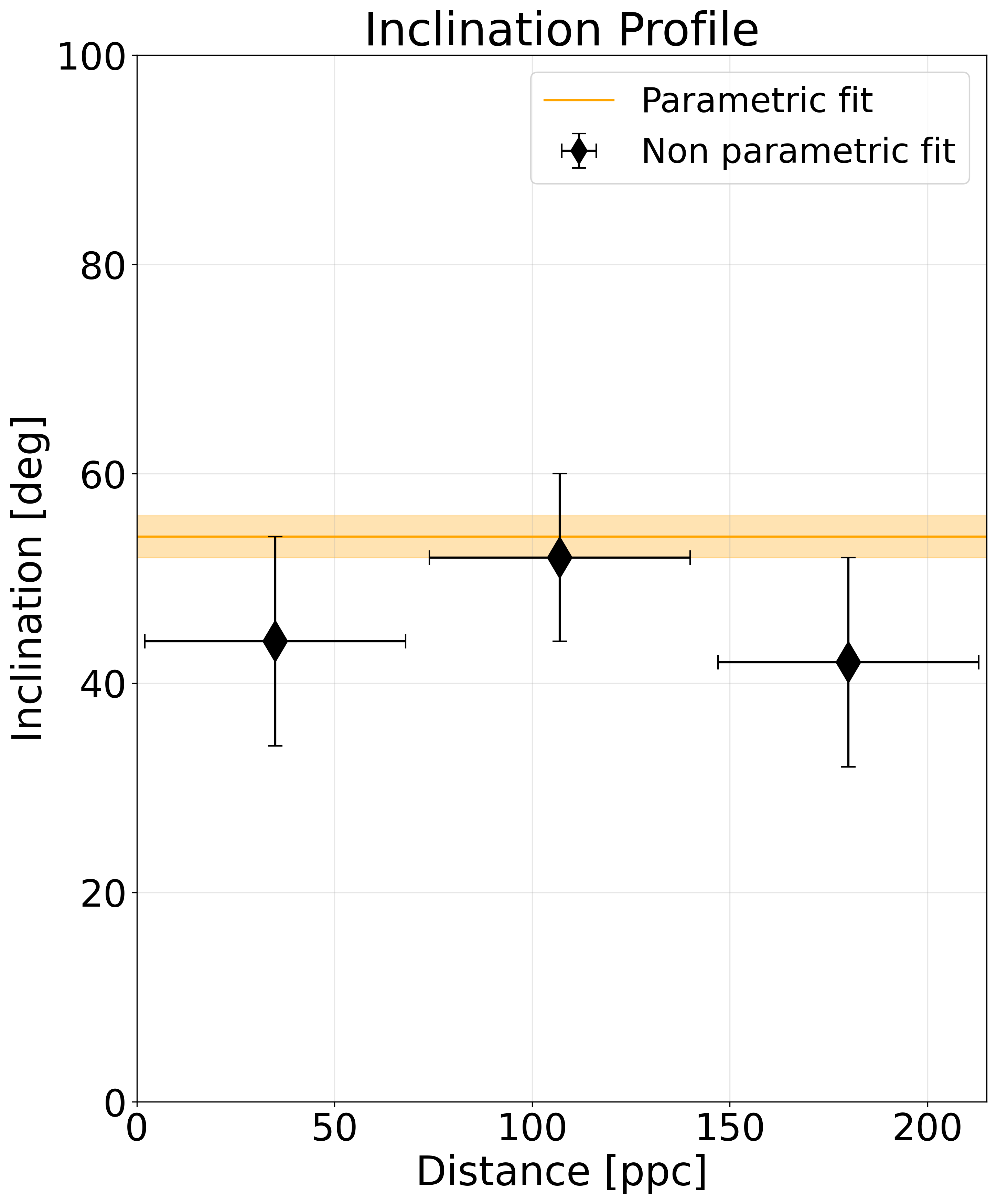
Figure 5: MOKA3D inclination constraints, showing agreement between parametric and non-parametric disk models.
Residuals for extended mass models remain systematically high, and biconical outflow models fail to reproduce the observed kinematics (χR2=9.6), confirming the dominance of the central point mass.
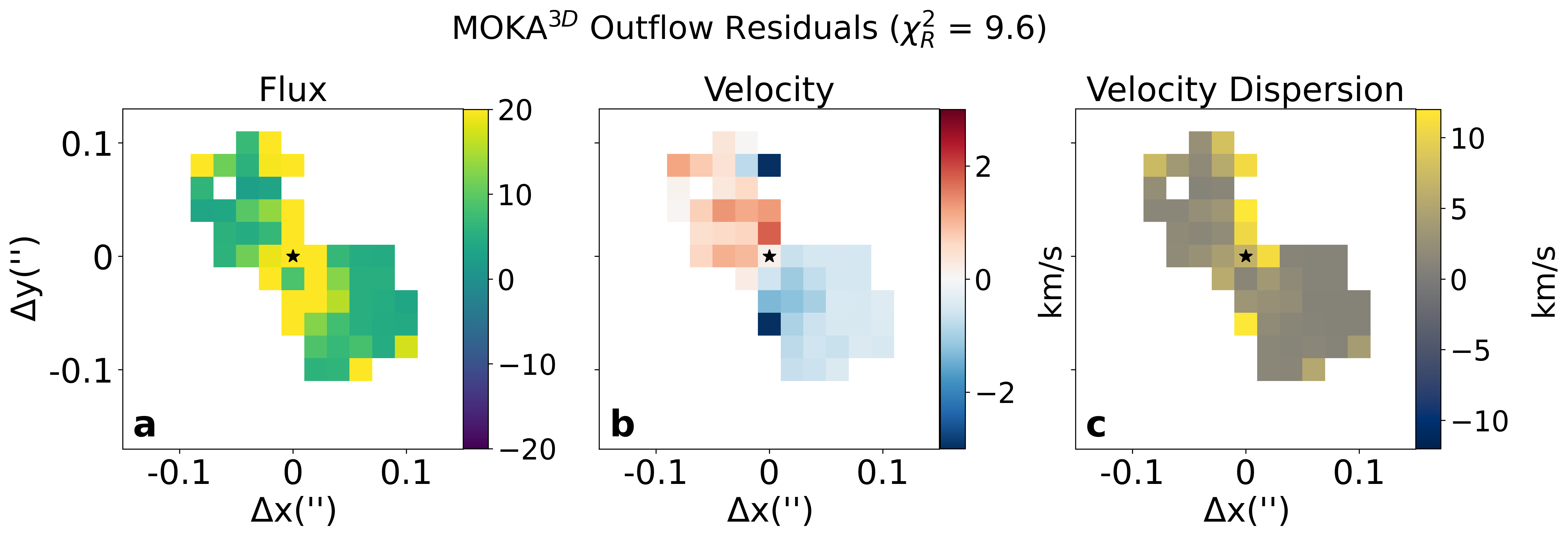
Figure 6: Residuals of a fit assuming a biconical outflow, demonstrating poor agreement compared to rotating disk models.
Comparison with Virial and Alternative BH Mass Estimates
The direct dynamical BH mass is compared with single-epoch virial estimates and alternative broadening scenarios (electron scattering, Balmer scattering). The dynamical and virial masses are consistent, validating the use of virial relations for LRDs at z=7. Electron scattering models, while fitting the line profile, yield BH masses nearly 2 dex lower, violating physical constraints.
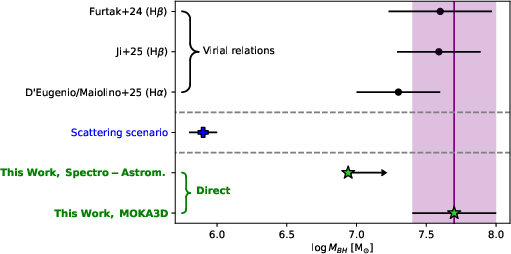
Figure 7: Summary of BH mass estimates for QSO1, comparing direct, MOKA3D, virial, and electron scattering scenarios.
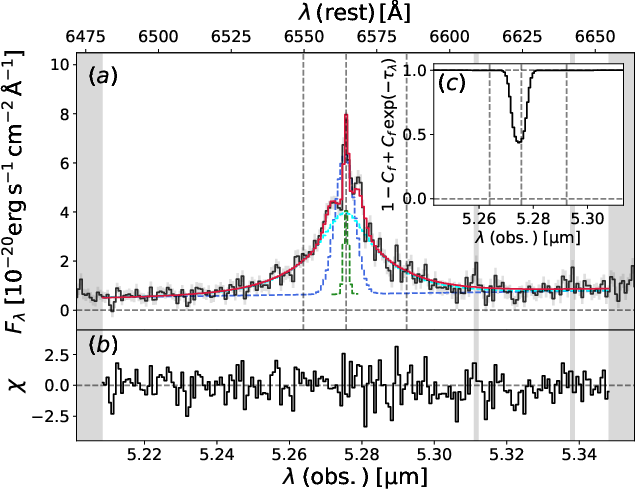
Figure 8: Fits to the line assuming electron scattering, showing good spectral fit but a BH mass 2 dex below dynamical measurements.
Host Galaxy Properties and Stellar Mass Constraints
Optical and UV continuum analysis, combined with dynamical modeling, constrains the stellar mass to M∗<2×107 M⊙, yielding MBH/M∗>2. This ratio is three orders of magnitude above local scaling relations, placing QSO1 at the extreme tail of overmassive BHs identified by JWST.
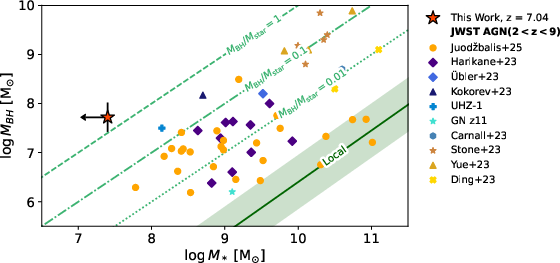
Figure 9: Location of QSO1 on the MBH vs. M∗ plane, highlighting its extreme overmassiveness relative to local relations.
Implications for Black Hole Seeding and Early Growth
The observed properties of QSO1—high BH mass, negligible stellar component, and near-pristine environment—are incompatible with standard stellar or extended mass scenarios. The only viable formation channels are "heavy seed" models: direct collapse black holes (DCBHs), primordial black holes (PBHs), or intermediate "Not-Quite-Primordial Black Holes" (NQPBHs). However, DCBH models typically predict MBH/Mdyn<0.1, more than 1 dex below the observed lower limit. PBH scenarios require significant accretion or merging to reach the observed mass, and the system's low metallicity provides some support for this channel.
Conclusion
This work provides the first direct dynamical measurement of a supermassive black hole in a Little Red Dot at the Epoch of Reionization, robustly ruling out alternative explanations based on extended stellar or dark matter distributions. The consistency between dynamical and virial mass estimates validates the use of virial relations for LRDs at z=7. The extreme MBH/M∗ ratio and chemically pristine environment indicate that QSO1 is a massive black hole seed in its earliest accretion phase, with implications for models of early black hole formation and growth. Future high-resolution spectroscopic surveys of lensed high-z AGN will be essential to further constrain the demographics and formation channels of the first supermassive black holes.









